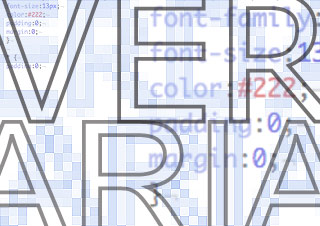 Each day HTML5 and CSS3 show up on my radar more and more, like some kind of incessant reality show that dominates the topic of conversation at the office water cooler. But in this case, HTML5 and CSS3 dominate Internet chatter and the trends I follow on Twitter, where HTML5/CSS3-related issues have really been picking up steam. As I alluded to here in my previous post about HTML5, and as evidenced by this article on the coming build of Internet Explorer 9, HTML5 and CSS3, compliance is likely to shift the balance of power in Web development software. Adobe (which is currently the dominant player in Rich Internet Application development) is likely to see their current market presence they’ve enjoyed curtailed by competitors such as Apple, Microsoft and Google who suddenly have a jones for the open standard HTML5/CSS3 offers.
Each day HTML5 and CSS3 show up on my radar more and more, like some kind of incessant reality show that dominates the topic of conversation at the office water cooler. But in this case, HTML5 and CSS3 dominate Internet chatter and the trends I follow on Twitter, where HTML5/CSS3-related issues have really been picking up steam. As I alluded to here in my previous post about HTML5, and as evidenced by this article on the coming build of Internet Explorer 9, HTML5 and CSS3, compliance is likely to shift the balance of power in Web development software. Adobe (which is currently the dominant player in Rich Internet Application development) is likely to see their current market presence they’ve enjoyed curtailed by competitors such as Apple, Microsoft and Google who suddenly have a jones for the open standard HTML5/CSS3 offers.
The future in question
The real question is, “Can all parties REALLY agree on the new HTML5 standard across the board, enough so that it will have a legitimate impact on today’s Web browsing and Web application experiences?” Adobe has even been accused of being an impediment to W3C green lighting the HTML5 standard. On the flip side of that coin, people have begun to analyze why they’re using Flash and other RIA technologies in the first place. Naturally, developers want to use the right tool for the right job and we can already see the effects of developers seeking rich media alternatives in the open market. One major example is the rise of using CSS and JavaScript frameworks such as JQuery for client-side scripting instead of Flash in some of today’s most innovative Websites. Gartner analyst, Ray Valdes, wrote a piece about HTML5 and the future of Adobe Flash, in which he lays out the current state of affairs. Of course, none of us truly knows what the future holds, but I doubt that the key players are sitting on their hands either. Several different players are trying to influence how the future takes shape; hopefully, open source methods will win out over licensed software.
Hurry up and wait
Long gone are the days when a simple text site adorned with goofy icons captured site visitors’ attention. Billions of dollars are at stake these days in the fight for user traffic. Site builders, on behalf of their clients, engage in that particular battle every day while trying to keep up with the competition AND remain relevant. Hence, they are improving their sites with sticky, interactive features. That being said, we live in a “What have you done for me lately?” world, and the dollars will go where they are most effective. Software vendors have been maneuvering forever to provide tools that site builders will want to use. Chess plays are being executed to gain top market positions and we all know how ugly that can get; let’s not forget how Microsoft put both Sun and JAVA into a corner several years ago, restricting them from bleeding into the Windows’ desktop experience. Companies like Microsoft maintain a split-personality agenda, creating proprietary products like Silverlight that they’re striving to seed in the developer market. It’s easy to see why the sharp elbows are out when you take a good look at the numbers. Worldwide application development software was a $7.3 billion dollar business as of mid-2008 alone.
The plot
This creates the context of a Dr. Evil-like plot in which each player fights for the loyalty of the very designers and developers who assist in creating the demand for software and merchandise for their peers and the masses. Adobe has long been treated as an unwelcome “guest” in the technology market and this disdain bubbled up in the early ’90’s as well when Apple and Microsoft teamed up to create the TrueType standard for fonts, leaving Adobe’s PostScript in the dust. Desktop publishing and electronic printing really took off and the impact felt by this current situation is likely to be just as large in scale. Tim Burden over at NewsFix executes a great write up with “Apple and Google go to war, Adobe takes collateral damage.” What really keeps Adobe’s competitors up at night is Adobe’s infiltration into the enterprise software market. I have a friend who works for an American soft drink giant that uses a home-brewed application consisting of a mixture of PHP and Adobe Flex to generate sales reports for the management that includes interactive bar charts and graphs, so I know that this threat is real.
The payoff
I’m paying attention to role descriptions and knowledge requirements for job openings that trickle my way, always gauging how these changes may affect my immediate world and job market. As a web developer, it’s hard to fight the feeling that you’re standing in the quicksand of an ever-changing technological landscape. Although, I know that some of us are making this “war” work to our benefit. I got word this week that a friend of a friend got a job offer of a quarter of a million dollars a year to be a senior Flex developer. Yeah, you read that right. As a person who mainly deals with U.I. and front-end design, I feel that the impact of HTML5/CSS3 on RIA workflows will be tremendous.
If compliance and HTML5 adoption within browsers pick up steam, I predict that the folks in charge of executing the design and function of Websites are soon to see their tools change in dramatic ways. Without a doubt, it will be slightly easier to implement data objects, UI behaviors, and to create slicker presentations on future Websites with “open source” tools. Having lived through the browser wars of the 1990’s, I can say definitively that smart people will still be around to pick up the pieces after big corporations beat the “propriety code” out of each other. I hope to be one of them.
More Resources
1. Jeffery Zeldman’s take on the IE9 preview
2. Sneaking into Future: 25 Ultra Modern Websites Using HTML5
3. Adobe shakes off all the noise about HTML5, by announcing new tool “Web Tech.”

 As of today HTML5 is no longer like a mythical white Unicorn, or just a new and cool buzzword uber-geeks throw around on Internet blogs. It’s something more real and tangible, thanks to
As of today HTML5 is no longer like a mythical white Unicorn, or just a new and cool buzzword uber-geeks throw around on Internet blogs. It’s something more real and tangible, thanks to  I’ve primarily used “Arial” and “Verdana” as my html text fonts. Recently, I’ve been re-visiting that as a rule. There’s been a number of Windows and Mac OS updates in the “wild” for a while now, so perhaps my options have expanded and I thought it’s a good a time as any to freshen up my work.
I’ve primarily used “Arial” and “Verdana” as my html text fonts. Recently, I’ve been re-visiting that as a rule. There’s been a number of Windows and Mac OS updates in the “wild” for a while now, so perhaps my options have expanded and I thought it’s a good a time as any to freshen up my work.